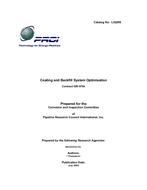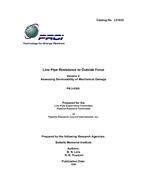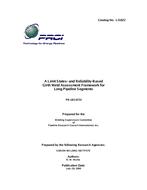Provide PDF Format
PRCI GRI-8704
- Coating and Backfill System Optimisation
- Report / Survey by Pipeline Research Council International, 05/01/2004
- Publisher: PRCI
$248.00$495.00
L52208e
Advantica Inc.
Need:
There is a clearly identified ongoing need to maintain the integrity and the safety of new and existing pipeline facilities. By minimizing coating damage during installation and service, the probability of compromising the pipeline's integrity due to under-film corrosion, stress corrosion cracking, AC corrosion etc. is significantly reduced. Coating selection without careful consideration of geotechnical conditions will increase the potential for coating damage. Consideration of the geotechnical conditions and backfill design in the selection of mainline, field joint and rehabilitation coatings could prove technically, economically and environmentally beneficial. This PRCI project focused specifically on the mechanical properties of a pipeline coating in relation to the need to use imported or site-processed bedding and padding materials to create the pipelines habitat.
Result:
Large-scale Tests
1. Large-scale tests have highlighted the significant variation in the mechanical properties of pipeline coating materials and their potential incompatibility with aggregates typically used to create the pipelines habitat.
2. Resistance to impact, penetration and abrasion damage is a fundamental requirement of pipeline coatings. This project has established the maximum size of bedding and padding with which to ensure the pipeline coating remains free of defects.
4. The benefits of using graded aggregate mixtures for large-scale testing are inconclusive. In a number of tests definite benefits have been realized whereas in others the benefits are less tangible. Although in practice, processed bedding and padding will consist of a range of aggregate sizes, the use of clean aggregates for test purposes is more appropriate as it allows a level of conservatism to be applied
5. The contact areas and hence the loading stresses that come to play during large-scale tests, and in practice, have been quantified for the three clean aggregates employed in this program of work. Knowledge of these parameters has allowed better small-scale simulation of the large-scale tests and hence what occurs in practice.
Small-scale Tests
1. Impact tups, and penetration and abrasion indenters have been designed to simulate the geometry and the minimum angularity and contact area of processed (crushed) aggregates.
2. The maximum point loading stresses, established from large-scale tests have been applied to develop the small-scale methodologies.
3. Impact tests have predicted:
a. The minimum particle size at which a coating failure will occur (from a fixed drop height)
b. The drop height at which failure occurs for a specific particle size
4. Penetration rates have been determined for a range of aggregate sizes. Aggregate size simulation has been achieved by varying the loading conditions.
5. Logarithmic regression has allowed the maximum penetration depth to be calculated for typical pipeline design lives.
6. Abrasion damage, at loads calculated to be representative of those that would prevail during service, has been quantified.
Correlation between Large and Small-scale Tests
1. The particle size at which coatings were predicted to fail using the small-scale impact test correlated well with the results of large-scale tests, providing that the appropriate impact tup geometries were employed.
2. Slight rotation of the pipe sample during the loading stage of the large-scale penetration test, which was not considered to be representative of what would occur in practice, affected the correlation between the two methodologies. Despite this, there was reasonable correlation with materials that possessed good abrasion resistance. It is anticipated that the large-scale penetration test could be modified to prevent pipe rotation and therefore improve this correlation.
3. Correlation between small and large-scale abrasion tests was not as strong as for impact and penetration tests, Good correlation was achieved in 50% of the tests, reasonable agreement in a further 20% and poor agreement in the remainder. Modifications to the tip of the abrasion indenter, to better replicate the surface roughness of aggregate particles, may improve the correlation.
General
1. Protocols have been developed for evaluating coating and backfill interactions. The information generated using these protocols will allow an operator to minimize coating, bedding and padding costs.
2. The correlations that have been established between small and large-scale tests will allow future field applications to be simulated using the lower cost, small-scale methodologies.
3. A greater understanding of the mechanical properties of pipeline coatings and their interaction with materials used to create the pipelines habitat has been developed. This knowledge will allow operators to be more prescriptive in specifying bedding and padding requirements for specific coating types. Ultimately, this will result in pipeline coatings and habitats that are optimised both technically and economically
Benefit & Recommendations:
The purpose of this project was to assess whether mainline and field joint coatings, typically utilized for pipeline protection, possessed sufficient mechanical resistance to withstand backfilling, commissioning and service with bedding and padding materials that had undergone minimal processing.
Test data from small and large-scale tests were used to develop a coatings and backfill algorithm. The algorithm is intended to help identify the maximum spoil size particular coatings can accommodate such that the appropriate level of processing of indigenous materials can be performed hence minimizing processing costs. The algorithm will assist operators in making financial decisions e.g. whether it is more economical to use a thin-film coating material and employ selective bedding and padding or to adopt a thick-film system that may eliminate or reduce the requirement for selective mater
Recommendations
1. Additional work should be conducted to fine tune small scale test methods based on additional field experience.
2. The large-scale penetration test procedure should be modified to prevent rotation during pipe loading. This will provide better correlation between small and large-scale test results on thin film coatings, and the conditions that prevail during pipeline service.
3. Large-scale tests should be conducted on a wider range of graded aggregate mixtures that are more representative of indigenous backfill materials typically employed during pipeline construction.
4. Small-scale abrasion indenters should be modified to better represent the surface roughness of aggregates likely to be used for bedding and padding.
5. The coating and backfill algorithm should be validated and updated based on practical experience.
Advantica Inc.
Need:
There is a clearly identified ongoing need to maintain the integrity and the safety of new and existing pipeline facilities. By minimizing coating damage during installation and service, the probability of compromising the pipeline's integrity due to under-film corrosion, stress corrosion cracking, AC corrosion etc. is significantly reduced. Coating selection without careful consideration of geotechnical conditions will increase the potential for coating damage. Consideration of the geotechnical conditions and backfill design in the selection of mainline, field joint and rehabilitation coatings could prove technically, economically and environmentally beneficial. This PRCI project focused specifically on the mechanical properties of a pipeline coating in relation to the need to use imported or site-processed bedding and padding materials to create the pipelines habitat.
Result:
Large-scale Tests
1. Large-scale tests have highlighted the significant variation in the mechanical properties of pipeline coating materials and their potential incompatibility with aggregates typically used to create the pipelines habitat.
2. Resistance to impact, penetration and abrasion damage is a fundamental requirement of pipeline coatings. This project has established the maximum size of bedding and padding with which to ensure the pipeline coating remains free of defects.
4. The benefits of using graded aggregate mixtures for large-scale testing are inconclusive. In a number of tests definite benefits have been realized whereas in others the benefits are less tangible. Although in practice, processed bedding and padding will consist of a range of aggregate sizes, the use of clean aggregates for test purposes is more appropriate as it allows a level of conservatism to be applied
5. The contact areas and hence the loading stresses that come to play during large-scale tests, and in practice, have been quantified for the three clean aggregates employed in this program of work. Knowledge of these parameters has allowed better small-scale simulation of the large-scale tests and hence what occurs in practice.
Small-scale Tests
1. Impact tups, and penetration and abrasion indenters have been designed to simulate the geometry and the minimum angularity and contact area of processed (crushed) aggregates.
2. The maximum point loading stresses, established from large-scale tests have been applied to develop the small-scale methodologies.
3. Impact tests have predicted:
a. The minimum particle size at which a coating failure will occur (from a fixed drop height)
b. The drop height at which failure occurs for a specific particle size
4. Penetration rates have been determined for a range of aggregate sizes. Aggregate size simulation has been achieved by varying the loading conditions.
5. Logarithmic regression has allowed the maximum penetration depth to be calculated for typical pipeline design lives.
6. Abrasion damage, at loads calculated to be representative of those that would prevail during service, has been quantified.
Correlation between Large and Small-scale Tests
1. The particle size at which coatings were predicted to fail using the small-scale impact test correlated well with the results of large-scale tests, providing that the appropriate impact tup geometries were employed.
2. Slight rotation of the pipe sample during the loading stage of the large-scale penetration test, which was not considered to be representative of what would occur in practice, affected the correlation between the two methodologies. Despite this, there was reasonable correlation with materials that possessed good abrasion resistance. It is anticipated that the large-scale penetration test could be modified to prevent pipe rotation and therefore improve this correlation.
3. Correlation between small and large-scale abrasion tests was not as strong as for impact and penetration tests, Good correlation was achieved in 50% of the tests, reasonable agreement in a further 20% and poor agreement in the remainder. Modifications to the tip of the abrasion indenter, to better replicate the surface roughness of aggregate particles, may improve the correlation.
General
1. Protocols have been developed for evaluating coating and backfill interactions. The information generated using these protocols will allow an operator to minimize coating, bedding and padding costs.
2. The correlations that have been established between small and large-scale tests will allow future field applications to be simulated using the lower cost, small-scale methodologies.
3. A greater understanding of the mechanical properties of pipeline coatings and their interaction with materials used to create the pipelines habitat has been developed. This knowledge will allow operators to be more prescriptive in specifying bedding and padding requirements for specific coating types. Ultimately, this will result in pipeline coatings and habitats that are optimised both technically and economically
Benefit & Recommendations:
The purpose of this project was to assess whether mainline and field joint coatings, typically utilized for pipeline protection, possessed sufficient mechanical resistance to withstand backfilling, commissioning and service with bedding and padding materials that had undergone minimal processing.
Test data from small and large-scale tests were used to develop a coatings and backfill algorithm. The algorithm is intended to help identify the maximum spoil size particular coatings can accommodate such that the appropriate level of processing of indigenous materials can be performed hence minimizing processing costs. The algorithm will assist operators in making financial decisions e.g. whether it is more economical to use a thin-film coating material and employ selective bedding and padding or to adopt a thick-film system that may eliminate or reduce the requirement for selective mater
Recommendations
1. Additional work should be conducted to fine tune small scale test methods based on additional field experience.
2. The large-scale penetration test procedure should be modified to prevent rotation during pipe loading. This will provide better correlation between small and large-scale test results on thin film coatings, and the conditions that prevail during pipeline service.
3. Large-scale tests should be conducted on a wider range of graded aggregate mixtures that are more representative of indigenous backfill materials typically employed during pipeline construction.
4. Small-scale abrasion indenters should be modified to better represent the surface roughness of aggregates likely to be used for bedding and padding.
5. The coating and backfill algorithm should be validated and updated based on practical experience.
Related Products
PRCI PR-003-9305
Line Pipe Resistance to Outside Force: Assessing Serviceability of Mechanical Damage..
$298.00 $595.00
PRCI PR-185-9733
Limit States and Reliability-Based Girth Weld Assessment Framework for Long Pipeline Segments..
$298.00 $595.00





